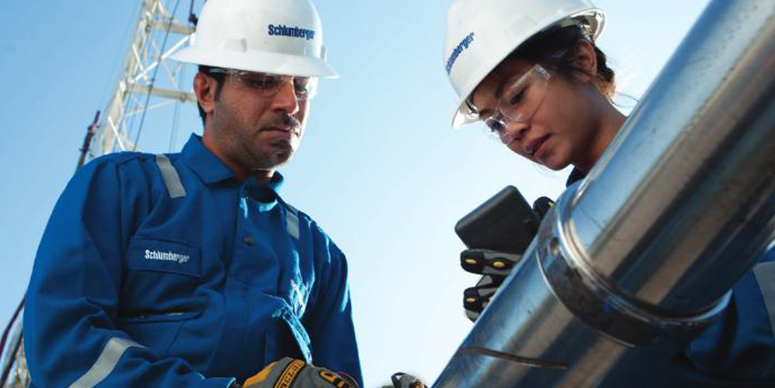Maximizing the net present value (npv) from coalbed methane (CBM) production requires maximizing the reserves and rate of gas extraction while keeping costs down.
Well design is key. Optimizing well design, placement, and completions, as well as stimulation and production, are key elements of this process. A successful project requires knowledge of the subsurface characteris tics of the target CBM reservoir, such as:
- location and distribution of the coal gas reserves
- producibility of these reserves
- mechanical characteristics of the coals and surrounding beds
- likelihood of water production from adjacent aquifers
- potential of commingled gas production from adjacent reservoirs. Well evaluation is the primary means of delivering this information.
Wireline geophysical logs, in particular, provide rapid measurements that can be used in wellsite decision making.
full range of well evaluation services
Schlumberger offers a comprehensive range of cased and openhole logging services giving data on coal thickness, depth, quality, and gas content, as well as the permeability and mechanical properties of the target coal seams and surrounding beds. These services can be adapted to meet the changing needs of the field based on the levels of existing knowledge.
Applications
- CBM exploration
- Optimizing well completion, stimulation, and production
- Guiding selective stimulation for individual coals
Benefits
- Significantly increases information about CBM reserves
- Guides well completion, stimulation, and production programs
- Reduces reliance on cores
- Produces rapid answers to assist decision making
- Allows comprehensive CBM evaluation in cased holes
Features
- In situ method for evaluating critical CBM production characteristics
- Discrete and cumulative coal gas content estimates
- Coal cleating evaluation using geochemical signatures or resistivity
- Coal and surrounding bed mechanical properties and stress profiles
- Cased hole and openhole evaluation options
Gas adsorbed to coal cannot be measured directly, but in situ gas content can be derived by correlating the coal properties, measured with logs, to the coal composition and gas content of representative core analyses. Coal cleat porosity is the primary mechanism controlling gas producibility and is also difficult to measure directly. Proven Schlumberger logging techniques for delivering these key CBM properties in situ include:
- traditional logs, such as the high-resolution density log, linked with innovative analysis algorithms to develop local models derived from existing core and production data
- advanced logs, such as geo- chemical logs, with processing and analysis tailored to the spe- cific needs of CBM, providing answers that are more accurate and comprehensive.
Cased hole geochemical logging
Two cased hole tools in particular, the ECS* elemental capture spectroscopy tool and the RST* reservoir saturation tool, increase operational efficiency by providing valuable CBM evaluation informa- tion without the need for openhole logging. These tools directly measure the chemical makeup of coal and ash mineralogy and are used to estimate the discrete and cumulative coal gas volume and the degree of cleating.
Total coal gas content and the gas adsorption isotherm at discrete depths are determined from the coal and ash content measure- ments. This is achieved by using an empirical relationship derived from proximate analysis and gas desorption/adsorption tests performed on core samples. This relationship is applied within a physical gas absorption model, such as the Langmuir equation.
high-resolution density MeAsureMent
The standard Schlumberger openhole logging suite for CBM well evaluation includes both bulk density and gamma ray measurements. It provides high-resolution delineation of the depth and thickness of coals because the bulk density measurement has a vertical resolution as high as 50 mm [2 in]. Coal quality is indicated by the magnitude of the bulk density drop. A local model can be developed to quantitatively predict coal grade, rank, and gas content from the log. This is achieved by calibrating the density and coincident photoelectric absorption factor (Pe) or the neutron porosity measurements with reliable core coal proximate, core gas content, and production data.
integrated openhole logging suite
The Platform Express* integrated wireline logging tool adds resistivity, microresistivity, and neutron porosity to the stand-alone density log. This provides a coal cleat porosity estimate from the resistivity and classical formation evaluation along with the coal quality and gas content estimate. The Platform Express suite also allows computation of synthetic compressional and shear velocities, using neural network local models. These velocities can be used to estimate mechanical properties and stress profiles for stimulation design.
openhole geochemical logging
A more accurate and reliable estimate of gas reserves, coal quality, and degree of cleating can be obtained by openhole geochemical logging with the ECS or RST tools. The geochemical log is a dry measurement with a 178 mm [7-in] depth of investigation, allowing both washouts and other environmental effects to be eliminated. Openhole geochemical logs can also provide a “ground truth” for subtracting contributions from casing and annular fill.
Combining the geochemical log with a density measurement enables a more general coal gas estimate to be made and increases the coalbed vertical resolution from 500 mm [20 in] to as sharp as 50 mm [2 in]. In addition, performing a full “wet” formation evaluation with density porosity of beds adjacent to the coal indicates how much water these beds may produce, which is important in deciding whether to perforate the coal or perforate an adjacent bed before fracturing into the coal.
sonic imagingmeasurement
A direct calculation of mechanical properties and stress profiles for stimulation design can be made when the DSI* dipole shear sonic imager tool is run. This tool measures actual compressional and shear velocities in coals and surrounding beds. It also allows computation of velocity anisotropy to assist in advanced oriented completions, for CBM basin evaluation, or as a secondary local indicator of cleating.
Cased hole sonic-neutron evaluation
In coal zones, compressional velocity decreases dramatically (delta t compressional increases), the same as in open hole. The neutron also increases dramatically because of the high hydrogen index of coals.
If sands in the section are gas-charged, again the compressional delta t increases, though not as significantly. The sonic increase is a function of the longer acoustic travel time through the gas than through the connate water of a wet zone. This is particularly evident through well-cemented casing where the gas has mi- grated directly behind the cement sheath. The neutron porosity decreases in these gas sands as a function of reduced hydrogen index relative to water- or oil-filled porosity.
When run with the CNL* compensated neutron log and gamma ray (GR) log, the Sonic Scanner* acoustic scanning platform, GR, and CCL casing collar locator suite works very well for
- identifying coal zones
- determining coal zone thickness
- qualitatively differentiating wet from gas-charged sands.
Each of the above factors can play a key role in CBM completion strategies.
sonic scanner platform
The new Sonic Scanner acoustic scanning platform offers significant advances in evaluating coals.
To enable a deeper understanding of acoustic behavior in and around the borehole, the Sonic Scanner acoustic scanning platform allows accurate radial and axial measurements of the stress and anisotropy- dependent properties of rocks near the wellbore. Its platform provides multiple depths of investigation, excellent waveform quality, and presentations that reduce the complexity of sophisticated sonic logging without compromising the depth of information.
The acoustic scanning platform provides advanced types of acoustic measurements, including
- borehole compensated monopole with long and short spacings
- cross-dipole
- low frequency Stoneley
- cement bond quality.
These measurements are then converted into useful information about the drilling environment and the reservoir, which assists in making decisions that reduce overall drilling costs, improve recovery, and maximize productivity.


 石油圈
石油圈
